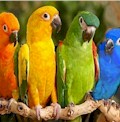With some time and perseverance, it is not such a difficult job to teach a bird to talk.
Whichever species of bird is selected for training, it is preferable to buy young and if possible, hand-raised birds, between 2 and 6 months old. A bird's learning ability is not as rapid, the older it becomes. It is much more difficult to teach a wild or untrained adult bird, as its own calls or whistles will have been firmly implanted in its memory.
However, a grown bird still can learn, but the owner will have to use more patience in teaching words to it.
There is much variation in their ability to imitate the human voice, whether hand-raised or wild, young or adult. This faculty depends on the species selected, the owner's teaching technique and patience, and most important, tameness of the bird itself. Half the success is assured with a bird which is calm and gives you a bold look when you approach it.
The different species of Amazon Parrots from the American Tropics are good talkers, some better than others. Cockatoos can also be taught to talk. Ravens, which are really big black Crows, will talk. Young ones are sold very reasonably. Less proficient talkers are: Macaws, Cockatiels, Conures, Magpies, the Lesser or Malabar Hill Mynah, Grass Parakeet, English Starlings, Love Birds and the larger species of Parakeets.
To teach a bird to talk, constant repetition of a word or short phrase is necessary. This can be done at different times, such as before removing the cover from the cage in the morning. In the dark with no distractions, a bird will concentrate on listening and answering back. Repeating words at feeding time, or when giving it a preferred tidbit helps also.
At times, when you may be out of sight, you may hear your bird trying to enunciate some word or phrase. This is a good opportunity to repeat what you want it to learn, or if the bird seems to be attempting a different expression from what you are teaching it, fit in words or a short phrase to go with the bird's vocal efforts and make them clear. Meanwhile keep out of sight and don't approach the cage.
Still another excellent method of teaching your bird to talk, whistle or sing a tune, is by having a phonograph record made with a few words or short phrase on it. If your own voice isn't clear and distinct, some friend of yours could oblige by repeating in the recording machine for you. The clearest voice is that of a child, next a woman's and lastly a man's.
When the record is made it should be played at different times during the day, and it will surely drill the lesson into your bird. Let's hope that you can stand hearing the sound of your own voice frequently. It is important when making a record, to limit it to a few words or a phrase only. If you change over to different words or sentences, your time and money are wasted. Birds have a small brain capacity and cannot assimilate too much at one time.
If you wish to teach it more make another record. The second record can have the previous lesson partly incorporated into it; however, emphasis should be placed on the new vocabulary. A criticism of some records sold ready-made is that they contain far too many words or sayings, which makes them worthless for teaching purposes.
Therefore, to build up a good vocabulary in a bird through the use of records, have a new one made for each lesson. The previous sayings may be repeated in parts of each successive record, till the last one contains everything the bird has been taught to say or whistle.
Using the above method, it will be no time at all before the bird you are training is able to talk.
